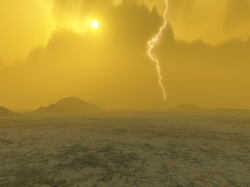Originally posted on April 7, 2009, only two months after Lights in the Dark launched:

I haven’t posted anything yet about our other neighboring planet, Venus, mostly because the currently active mission exploring it, the European Space Agency’s Venus Express orbiter, hasn’t been updating much with new images since I’ve begun this site. Still, Venus deserves some attention, so here’s a quick byte of Venus info.

Possibly the most inhospitable of planets in our solar system, the “evening star” Venus is permanently enshrouded by thick yellowish-beige clouds. In order to see any cloud structure at all, images must be made in other wavelengths of light….infrared, or ultraviolet (above). In these wavelengths invisible to our eyes, the swirling structures of Venus’ atmosphere can be made out. And what an atmosphere it is! An example of greenhouse effect to the nth degree, our neighboring Venus is a virtual oven…its scorched, rocky surface baked by 800ºF + temperatures beneath the crushing weight of its own incredibly dense atmosphere, standing “sea level” on Venus would be like being hundreds of feet underwater, just in terms of pressure per square inch. And if the heat and pressure weren’t enough, the skies are full of clouds made of corrosive sulphuric acid as well, lit by bolts of lightning and and whipped by incredible planet-wide winds clocked in the hundreds of miles per hour. All Earth-based probes that landed there (such as the Soviet Venera-13, seen below) only lasted moments on the surface before they succumbed to Venus’ destructive environment.

Venus is, quite literally, a hellish place. And, oddly enough, it is the planet that most resembles Earth, in terms of size and composition. It’s an example of how being just that much closer to the sun, without the benefit of any carbon-dioxide processing life forms like Earth has developed, drastically changes an entire planet. I may not be the most militant tree-hugger but I do realize the unmistakable effect plant life has on our world. Venus shows us what Earth could have been. Quite easily. And very well could still become. And that’s why the ESA’s Venus Express mission is so important.
More images from the Venus Express mission here.
Image credit: ESA/MPS/DLR/IDA. Venera-13 image remapped by Don P. Mitchell.
__________________
Update: check out this great article on Venus by Robert Lamb, posted March 22, 2011
2 Comments
Comments are closed.